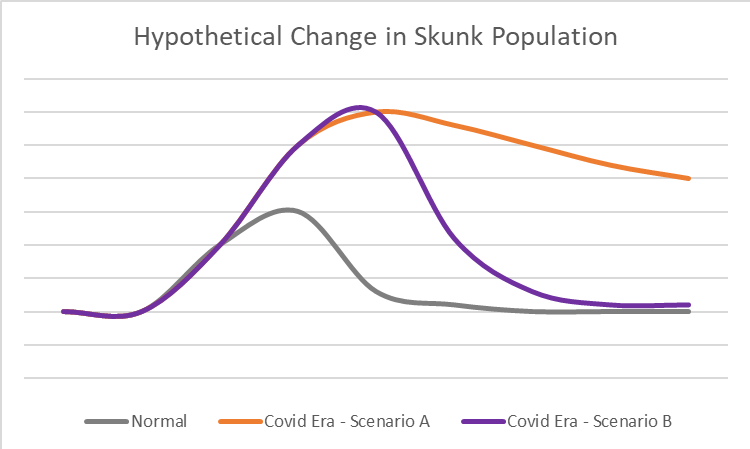Editor’s note: Lincoln Merrihew is an independent consultant, research and insights, Boston.
COVID-19 was an unforeseen crisis. In this article, I will leverage some simple data related to COVID-19 to show how insights can be discovered and shared using storytelling and analytics. The best way to do this is by first identifying the known data; extrapolating new insights from those data; and finally predicting or inferring across the resulting data.
The three-step approach is applied in this article to connect a hypothetical biology-related impact of COVID-19 to business applications. I’ve chosen biology to avoid even remotely suggesting that a particular industry or brand is taking, or will unfairly take, advantage of the current turmoil.
The purpose of the article is to show how a logical and analytical deduction path – plus a little creativity – can be used for business storytelling even when using unexpected variables using these elements:
- What we know.
- What we can extrapolate from what we know.
- What we can predict from what we extrapolate.
What we know
 Many people are staying home and going out less – for both work and pleasure. This means we are driving less and there are fewer cars on the road. We also know there has not been an immediate and shocking change in climate patterns over the past 90 days. Spring seems to have sprung. The lack of dramatic climate change suggests that wild animal breeding has continued on par with normal seasonal patterns and that birthrates should be fairly typical. Fewer cars, same increase in the animal populations. We also know that natural selection favors those best able to adapt. So normally, animals better able to avoid moving vehicles are the ones most likely to survive to adolescence.
Many people are staying home and going out less – for both work and pleasure. This means we are driving less and there are fewer cars on the road. We also know there has not been an immediate and shocking change in climate patterns over the past 90 days. Spring seems to have sprung. The lack of dramatic climate change suggests that wild animal breeding has continued on par with normal seasonal patterns and that birthrates should be fairly typical. Fewer cars, same increase in the animal populations. We also know that natural selection favors those best able to adapt. So normally, animals better able to avoid moving vehicles are the ones most likely to survive to adolescence.
Extrapolate from what we know
From a constant level of wild animal births combined with a sharp drop in vehicular traffic, we can extrapolate that the survival rate of those offspring will be much higher than normal (i.e., fewer road-crossing fatalities than normal). For example, the survival rate for baby skunks (called kits) in normally well-trafficked areas is likely to be much higher than normal. Skunks have poor vision and so are often more susceptible to vehicular collisions, so a lack of vehicles will likely disproportionately aid that population. Extrapolating from that suggests an increase in the adolescent skunk population.
Predictions
Let’s sniff out a prediction of what could happen as the result of a surge in adolescent skunk ranks using two scenarios. We’ll assume that road traffic increases to more normal levels toward summer in both scenarios.
Scenario A: Adolescent skunks are somewhat smarter than kits. That means adolescent skunks will be less likely to fall victim to roadkill and will more often successfully grow into adult skunks. With additional adult skunks roaming around, more dogs will likely get sprayed and more yards will be torn up by skunks looking for grubs and the like.
The odiferous dogs will create incremental business for companies that specialize in dog grooming and for makers of dog shampoos and related products. Instances of severe spraying may mean incremental business for veterinarians. The torn-up yards (and possibly just skunk scent in general) may be a boon to services that specialize in skunk control.
Scenario B: Adolescent skunks are no smarter than kits, or any incremental intelligence is negated by their poor vision. In other words, the adolescents suffer the same fate as the kits normally do, just a few months later. That in turn means more vehicles will smell like skunk – and to a higher degree than normal because the skunks will be older and larger. That may create incremental business for car washes, detailers, auto parts stores selling specialty cleaners and potentially auto repair facilities to the extent the skunk events cause accidents. Likewise, those companies that sell ingredients for home-made skunk odor-control remedies may also reap benefits.

Reasonable, defendable extensions
Context and trending are important as well. While car washes, for example, might see incremental business from more teen skunk incidents, that would only be partially backfilling for business lost while people were not driving as much.
The purpose of this article is not to suggest investing in pet care companies, veterinarian offices or carwashes. Rather, it’s to illustrate ways to make reasonable and defendable extensions from data you know to yield business insights using atypical data to get your attention. This approach is applicable to just about any set of data and it’s important to distinguish which elements fall under which heading (known, extrapolated and predicted) when presenting results.
